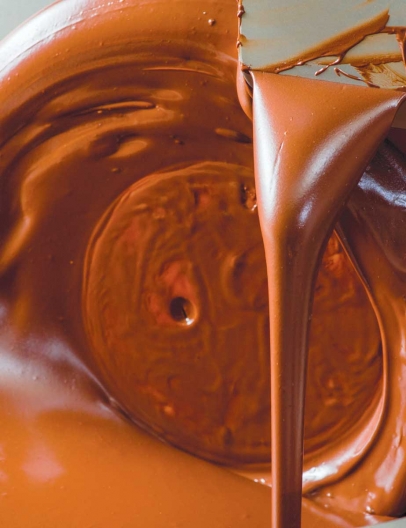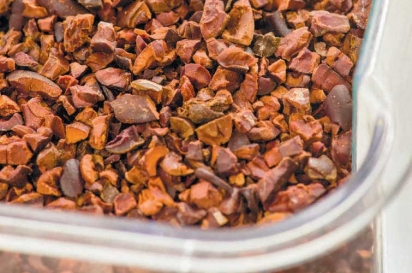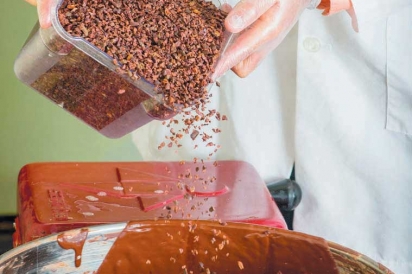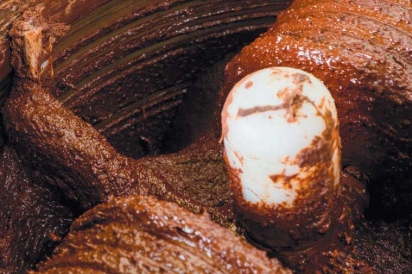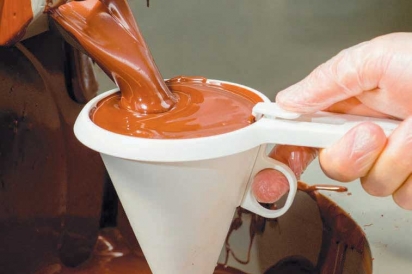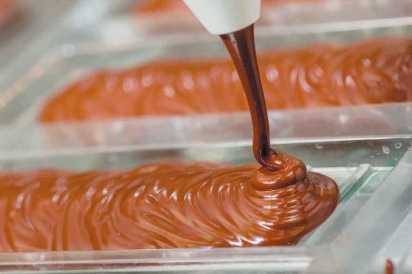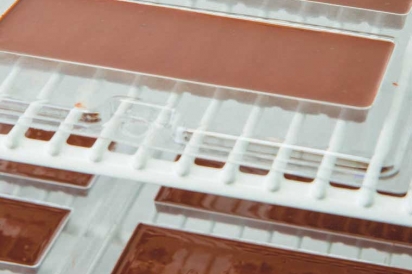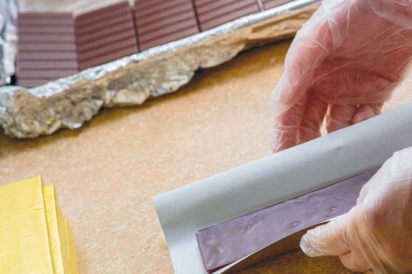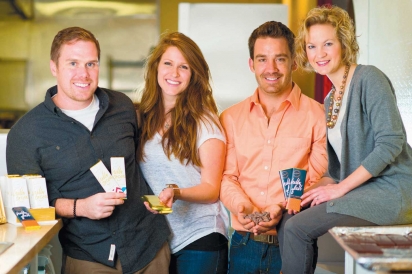Hello, Cocoa
When many people think of divinely delectable foods, chocolate tops the list. Chocolate is, after all, made from the fruit of the cacao tree, whose name, Theobroma cacao, literally means "chocolate, food of the gods." This delicious and versatile food is once again celebrated, this time through the opening of Hello Cocoa. This startup company is transforming raw cacao beans into beautiful, mouthwatering chocolate bars.
The "bean-to-bar" approach is not new, but how and why is it happening here? Who are these people who think that Northwest Arkansas is the place for a chocolate company? And, perhaps most importantly, how can Ozarkansans get their hands on some locally crafted chocolate? In October, Edible Ozarkansas spent some time with Hello Cocoa in their shop watching the process of chocolate-making, talking cacao beans and cocoa percentages, and sampling the goods. It was time deliciously spent.
Three couples founded Hello Cocoa. Charles and Abby Davidson bring business skills and techniques to Hello Cocoa that they developed in ForgottenSong, a non-profit organization whose primary purpose is to develop sustainable start-ups in war-torn countries. Functioning out of commercial kitchen space adjacent to ForgottenSong in south Fayetteville, the two companies share the same ethos of globally minded business that, as co-founder Lauren Blanco puts it, "honors and respects the dignity of each party, bringing joy to each other's lives." Lauren and Mark Blanco of Springfield, MO, cover design/marketing and finances, respectively. Preston and Abby Stewart carry out a good portion of the actual processing and manufacturing of the chocolate itself, thanks to Preston's scientific background and their shared love and passion for food. In the fall, this team of six was currently producing about 1,200 chocolate bars per month, with production expected to double soon.
Charles says that the idea began as a seed in the minds of some of the founders when they were spending time in Uganda doing work for ForgottenSong. They met a chocolate farmer named Cosmos who shared some of his freshly harvested cacao beans, grown from trees planted as an inheritance by his father. While the flavor of the chocolate itself was a captivating experience, the realization that chocolate has such a capacity for narrative seemed to become the inspiration for Hello Cocoa. The founders wanted the people of Northwest Arkansas to join that narrative, and, through their chocolate, travel to Uganda to meet Cosmos and taste the fruits of the work he is doing there.
Hello Cocoa currently has two varieties of dark chocolate bars for sale and produces a third, seasonal bar, as possible. In the fall, the seasonal addition was appropriately named Hello Fall. Hello Fall was a dark chocolate bar with pumpkin seeds, dried cherries, and pumpkin pie spice – just as glorious as it sounds. The winter bar, Winter Wonderland, features dried cranberries, cacao nibs, and orange zest. "The flavor is bright and cheery, just like the holidays," says Blanco.
Locally crafted chocolate bars in the making
Hello Cocoa bars are unique due not to the ingredients mixed in but because of the origin of the cocoa used. One is from Venezuela, and the other, in honor of Cosmos, is from Uganda. And the beans from these two nations are about as different from each other as Spanish is from Bantu.
Uganda (and all of Africa) primarily grows what is known as Forastero cacao, the hardiest and most prevalent of the four different varieties of beans. Venezuela, on the other hand, is known specifically for a very difficult-to-grow, fragile, lowyield variety known as Criollo cacao. The Forastero bar from Uganda is straightforward, with a deep, dark and sultry flavor – think rich, hot chocolate. By comparison, the Venezuelan Criollo is delicate and complex. Less chocolatey, it is fruity and nutty, and has much more of what are referred to as "secondary notes." This is where chocophiles love to geek out. So, perhaps a brief tutorial in chocolate flavor profiles is in order.
The flavor profile of chocolate includes several distinctive categories: cocoa, floral, fruity, nutty, earthy, vegetative, spicy, and caramel. Each of these is often broken down into further subcategories – for example, a certain chocolate bar might be described not just as fruity but as having either "tropical fruit" or "stone fruit" notes. Taken even further, many chocolate makers will specify a bar as having notes of cherry, apricot, or plum. So, things get rather specific for chocophiles.
What determines these flavors? Both the variety of bean and its origin play a significant role. Different regions grow the same cacao varieties with wildly different results depending on the region's terroir – its climate, soil, and topography. A third factor is the length and style of an interesting fermentation process the beans undergo immediately after picking. The beans are laid out in large trenches for several days, inducing a fermentation process much like what happens in beer, wine, or sourdough bread. Proper fermentation (and subsequent drying) is crucial for the development of the flavors locked in the beans.
It is important to note that the cacao farmers guide all three of these factors. A significant portion of the flavor development is completely out of the hands of the chocolate maker. What, then, does the chocolate maker actually do once he gets his hands on the beans?
The bean-to-bar process involves several distinct steps at Hello Cocoa. While many larger chocolate companies have highly automated systems in place, Charles and his team take a very hands-on approach. (Shown at left.) The beans arrive in giant, beautiful burlap sacks that seem more like chic decorations than functional storage vessels.
Once checked for quality, they are roasted in small batches, cracked by hand in a Crankandstein mill, and winnowed using some so-called "Ozark engineering" involving a shop vacuum and some cleverly rigged PVC piping. At this point, the beans are in a form called cocoa nibs – small pieces of roasted cocoa bean that are wonderful as a mix-in or topping for any number of desserts, or great to eat on their own.
However, it's still not chocolate. From here, the beans, along with some cocoa butter and sugar, are poured into a melanger, which grinds the nibs down to particles about 20 microns – or two-hundredths of a millimeter – wide, and the mixture turns into a silky smooth liquid. If the nibs aren't ground long enough, the chocolate comes out gritty. Too long, and it's gummy.
After several days in the melanger, the chocolate must be tempered. A careful process of temperature manipulation in what looks like a fancy fondue pot guides the fat molecules into proper alignment. The chocolate must undergo this process if it is to remain shiny, crisp, and confidently solid at room temperature. Poorly tempered chocolate often looks dull or blotchy and begins melting immediately upon contact with human hands.
Next, the chocolate is poured into molds, gently chilled, and wrapped in Hello Cocoa's beautiful gold foil and travel-inspired packaging. All of this is done by hand, and that human touch is evident both in the beautiful folds of the packaging and in the wonderfully subtle swirl pattern visible on the back of the chocolate bars when the chocolate catches the light. No machine molded these bars – each was hand-poured by people as excited about crafting their chocolate as Northwest Arkansas seems to be about eating it.
Haven't tried Hello Cocoa yet? Stop by Onyx Coffee Lab, Handmade Market, Masons, or Arkansas Fresh Market and grab a bar. The Hello Cocoa Facebook page offers even more places to find their chocolate. The packaging for the bars inspires a sense of adventure with its passport stylizations and oozes sophistication with its simplicity, but don't be intimidated. The chocolate is as accessible as it is thrilling. And it is rich enough that a single bar is shareable with a friend over more than one sitting (although the author certainly won't judge the more, ahem, "determined" adventurer).
About cooking with high-quality chocolates
Higher-qualtiy chocolate bars, such as Hello Cocoa bars, are wonderful for baking, with a couple of caveats. They aren't great as mix-ins for recipes such as chocolate chip cookies. Traditional chocolate chips are actually made from a lower-quality chocolate. Lower-quality chocolate holds its shape when baked primarily due to its lower cocoa butter content. Highqualtity chocolate will not do that. Similarly, higher-qualtity chocolate bars don't substitute perfectly for standard "baking chocolate," again due to differences in fat content.
Here are a couple of recipes to test out using a high-quality chocolate bar. Follow these recipes, or use them as a jumping off point for a new adventure with chocolate.
THE WORLD'S RICHEST HOT CHOCOLATE
Recipe by Christopher Eads
A simple mug of hot chocolate highlights the deep and intense cocoa f lavor of chocolate by taking the bean back to its roots in Mayan and Aztec cultures, where it was known as xocolatl.
Ingredients
- 2 ounces dark chocolate, such as Hello Cocoa's
- Ugandan Forastero bar, chopped
- 1 cup milk
- pinch salt
- pinch cinnamon
Instructions
- Add all ingredients to a small saucepan.
- Heat over medium-low, and stir until chocolate is melted and well blended, about 5-7 minutes.
FRUIT AND CHOCOLATE TART
Recipe by Christopher Eads
This flexible chocolate tart makes use of fruit preserves from local farmers markets for a pairing that highlights the tart's simple, high-quality ingredients.
Ingredients
-
2 1/2 cups all-purpose flour
- 1/2 teaspoon salt
- 1 teaspoon sugar
- 1/2 cup ice-cold butter, cut into tablespoon-sized pieces
- 1/2 cup ice-cold lard, cut into tablespoon-sized pieces
- 1/2 cup ice-cold water, as needed
Chocolate Ganache
- 8 ounces dark chocolate,
- such as Hello Cocoa's Venezuelan Criollo bars
- 1 cup heavy cream
- 6 ounces local fruit preserves (such as blueberry, blackberry, or grape)
Instructions
- In a medium mixing bowl, whisk together flour, salt, and sugar.
- Add butter and lard to the flour mixture. Using a pastry blender, two knives, or a stand mixer, cut the butter and lard into the flour until lumps are approximately pea-sized.
- Add three tablespoons of ice-cold water and stir into flour mixture. Quickly but carefully continue to add water bit by bit while mixing, until the dough comes together.
- Form dough into a ball, cover with plastic wrap, and refrigerate at least 30 minutes before rolling. Dough can be made the day before and held in the refrigerator.
- Once dough is chilled, preheat oven to 425°. Roll dough out and place into a 9-inch pie dish, pressing into bottom and sides. Trim off excess crust and flute edges. "Dock" dough by poking holes through base of the crust with a fork (this allows steam to escape while the crust is baking) and bake until crust is a light golden brown, 8-14 minutes depending on the thickness.
- While crust is baking, chop chocolate into small pieces and place in a small mixing bowl.
- Heat cream just to boiling and pour over chopped chocolate. Allow mixture to stand five minutes, then mix gently with a whisk to combine thoroughly into a smooth, chocolate ganache.
- When crust is golden brown, remove from oven and fill bottom with fruit preserves. Layer chocolate ganache on top of preserves and chill 20-30 minutes before slicing. (The tart can certainly be eaten warm as well if you don't mind a gooier experience!)


